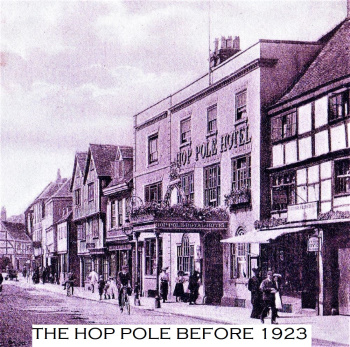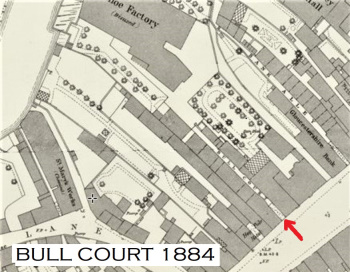Bull Court: A Long-Gone Alley
to Expand
The front house seems to have been a butcher’s shop in the nineteenth century, with a slaughterhouse, probably the workshop building, in the court. In 1889, though, it was James Hopkins’ greengrocer’s shop, taken over by Frank Bloxham in 1904. By 1907 it was Smith’s pork butchers becoming the home of the Tewkesbury Food Committee at the end of the Great War. In about 1923 it was converted to its present form, to become part of the Hop Pole during a major upgrade of the hotel. It was then that redundant windows from work at the Cross House, up the road, were reused to replace the shop frontage and give the facade we see today.
There were six cottages, with thirty-one occupants, in the court in 1841. By 1851 only three were occupied, soon falling to two. In 1907, the front house, two cottages and a three-stall stable were advertised for sale, along with the warehouse or workshop, which became part of the YMCA in 1921.
Bull Court’s cottages seem to have been respectable and law abiding. Occupants were certainly not affluent, and they suffered from the universal problems of overcrowding and poor water supply, but otherwise life was quiet.
The court was in the news in 1905 when Reuben White slipped and fell off a railway wagon whilst loading sacks of barley malt. He was forced to sue his employers, William Rice and Co., corn merchants, who wouldn’t make the payments due under the then new Workmen’s Compensation Act, saying that it applied to working in factories and the railway siding was not a factory. They lost. They appealed. They lost again and Reuben was awarded about £8. A small victory for the working man.
This court of two cottages suffered greatly during the Great War, losing three sons. Charles Hurcombe was killed in action in March 1915 and his brother Harry gassed in 1917. The Mann family next door fared little better, with Louis being killed in August 1916 and Fred wounded and hospitalised a month later.
Mr and Mrs Mann seem to have been the last residents of the court, which was sold in 1919. The warehouse was sold to the YMCA who linked it to their building next door. The remainder was incorporated into the Royal Hop Pole. It’s days of independent existence had ended, except for Mop Fair days when it was set up as a dummy ward to raise funds for the hospital. This, too, ended when the fair retreated out of Church Street.
An attractive, but quiet, part of the street scene, it’s hard to imagine what the entrance was like in its heyday, with houses and a tanyard within it.
to Expand
Bull Court lost its identity a hundred years ago, but is possibly the oldest identifiable alley in Tewkesbury.
Today, it is part of the Hop Pole; the archway nearest the Cross used as their wheelchair access. It hasn’t always been part of the Hop Pole, though. It’s ‘front house’, identifiable by its windows, was once the Bull Inn. In about 1540, Clement Base rented half a burgage at the sign of the Bull, for 6d. In 1589, Mr Foskewe, the visiting Deputy Steward, presiding over the town’s Michaelmas Court, dined at the Bull. An inventory listed stables and a brewhouse in the court.
By the eighteenth century, the court led to Hartland’s, later Bolding’s, tan yard. In the early censuses, most of the cottages in the court were occupied by tanners, suggesting that the business was thriving. Later, the tan yard closed becoming the ‘Eagle’ factory site (and now Elliot Court).
The Hartland family had retained ownership because in 1889, following the death of Anna Maria Hartland, a large block of land, between Bull Court and Bank Alley, extending to the Mill Avon was sold by auction, in lots. Bull Court was described as a Front shop and dwelling house, with two cottages, workshop, wash house with hard and soft water pump, and stable.
Census Data 1841-1891
- Mary Ann Wyse (Wise) died aged 83 at Bank Alley on 14th Dec. 1893 (TR 16/12/1893)
- Mary Ann Wyse (Wise) died aged 83 at Bank Alley on 14th Dec. 1893 (TR 16/12/1893)
- Mkealauna@aol.com : William Albert Edwards died 14 November 1903 after being injured in the Stanway Viaduct Disaster on the 13 November 1903.
- Henry was born in 1859 at Pipersend, Longdon, Worcestershire. He became a Blacksmith. On the 1881 census, he was a Blacksmith lodging at 21 Barton Road, Tewkesbury. He walked to Birmingham and married there on 15th November 1884. [Mkealauna@aol.com]




Comments